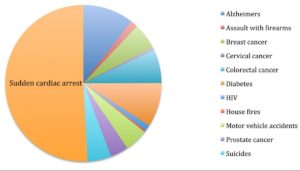Save A Life On Campus: Know When, Where And How To Use An AED

You’ve probably walked by an AED every day without even taking notice. Did you know that Colorado State University has more than 200 AEDs installed throughout campus? Knowing their locations could save a fellow Ram’s life.
Look for AED signs along the walls of popular campus buildings, or visit CSU maps to view the location of all AEDs. Simply select the “health and safety” option from the left-hand navigation menu. From there, select “AEDs.” Clicking on the AED symbol for a specific location will provide a detailed description and/or photo of the AED location within the building. With this simple tool, you can be prepared at a moment’s notice to save someone’s life. AEDs are for everyone’s use, even without prior training. And every second counts!
AEDs (automated external defibrillators) are used to treat sudden cardiac arrest, a leading cause of death in the United States. Sudden cardiac arrest (SCA) claims one life every 90 seconds and kills more people than Alzheimer’s disease, assault with firearms, breast cancer, cervical cancer, colorectal cancer, diabetes, HIV, house fires, motor vehicle accidents, prostate cancer and suicides combined. Of the individuals who experience SCA, 95 percent of them will die because immediate treatment is not provided. (source: phillytrib.com) This is where you come in!
Statistics
When bystanders intervene by giving CPR and using an AED before emergency medical personnel arrive, four out of 10 victims survive. Unfortunately, only 32 percent of SCA victims receive bystander CPR and only 2 percent are treated with AEDs. Don’t let this be true for CSU! AEDs are designed for anyone and everyone to use, with or without training. The AED will first diagnose the victim to determine if SCA is the true cause of the symptoms. It will scan the victim for abnormal heart rhythms, and if detected, will deliver a shock to restore a normal heart rhythm. AEDs provide simple audio and visual instructions telling the user exactly how to operate the device. Anyone can do it! (source – www.sca-aware.org)
If you are interested in learning more, please go to CSU’s AED/CPR website, where you can find additional information and access to both online and instructor-led AED trainings. Both are offered at no cost. Or for $99, consider taking CSU’s American Red Cross-sponsored course, offering a two-year certification in adult, child and infant CPR, AED and first aid. Explore all your options here.
Even without training, knowing the location of the nearest AED can save the life of person experiencing sudden cardiac arrest. Be prepared to jump in and assist. Remember, Rams take care of Rams!
Story Credit: https://source.colostate.edu/save-life-campus-know-use-aed/


